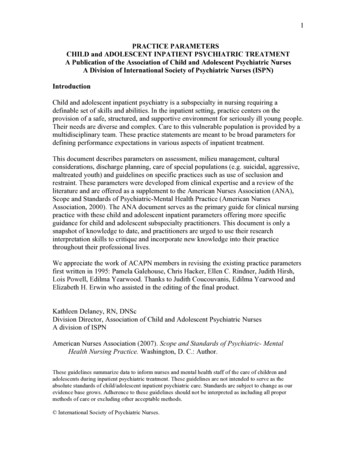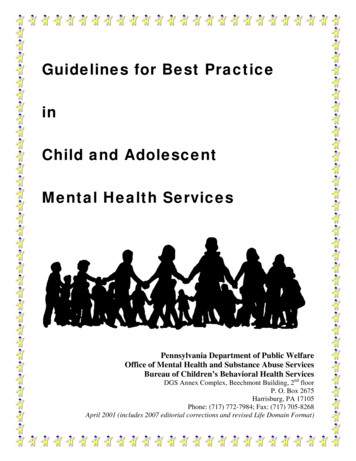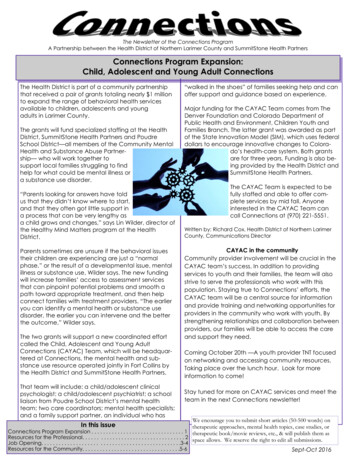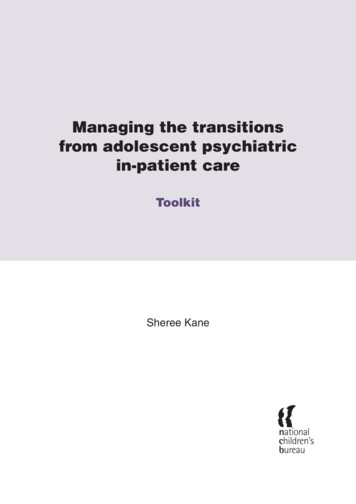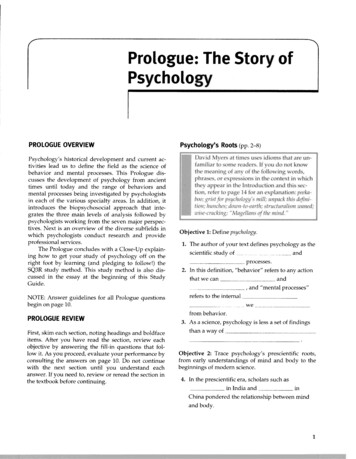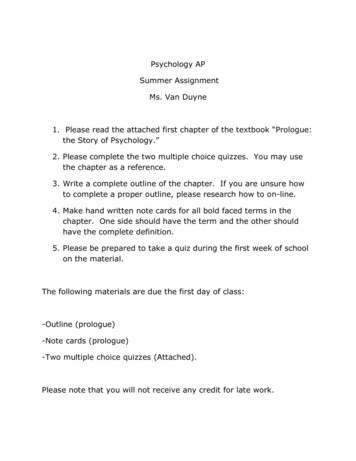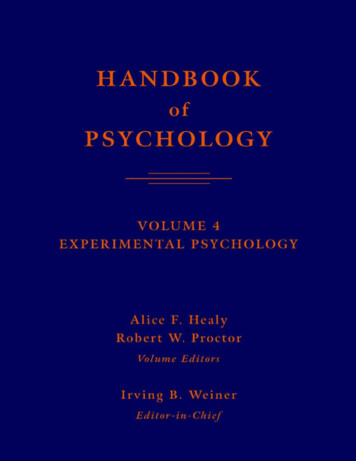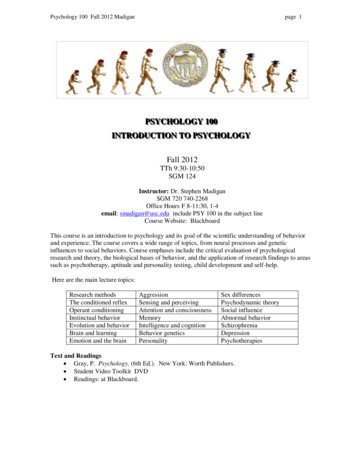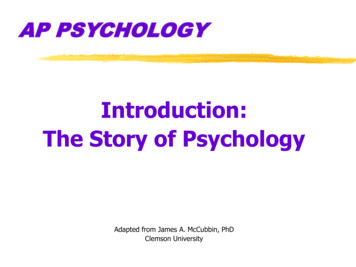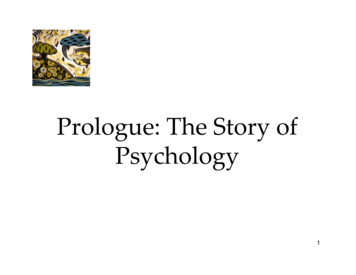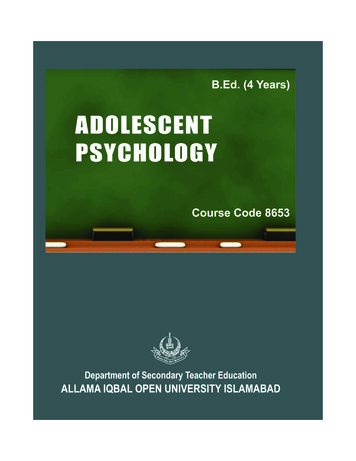
Transcription
ADOLESCENT PSYCHOLOGYB. Ed. (4 Years)Course Code: (8653)Units: 1–9Faculty of EducationDepartment of Secondary Teacher EducationALLAMA IQBAL OPEN UNIVERSITY, ISLAMABAD
Print Line(All Rights Reserved with the Publisher)Edition1st First Printing.No. of copies .Composed by .Price .Printer.Publisher . Allama Iqbal Open University, Islamabad.ii
COURSE TEAMChairman Course Team:Dr. Naveed SultanaCourse Coordinator:Dr. Naveed SultanaCourse DevelopmentCoordinator:Dr. Sidra RizwanWriters:Dr. Rehana RehmanMr. Shahzad AhmadDr. Ghulam DastageerMr. Inam JahangirReviewers:Dr. Naveed SultanaDr. Munazza AmbreenDr. M. Tanveer AfzalDr. Sidra RizwanEditor:Mr. Fazal KarimLayout & Design:Mr. Mateen Ishfaqiii
PREFACEEducational psychology as the science of education intends to improve theprocesses and products of education. It provides the modes and ways for helpingthe teachers, teacher education, the educational planners, the administrators andsocial workers in their respective areas of activity through which they will be ableto help the adults or younger generation in their pursuit of education.As new developments occur in education, research adds new insights on teachingand learning, new ideas are developed, and as times change, beliefs aboutAdolescent Psychology also undergo transformation. The rightness or wrongnessof concepts like psychology related issues of adolescents cannot be established byan individual educationist or even by a group of educators. One index ofcorrectness might be the prevailing opinion of most educators at a particular stagein history.No education teacher, curriculum coordinator, administrator, or tutor in distancelearning system of AIOU would dream of arguing that techniques of coping withthe concept of Adolescent Psychology should be part of the curriculum of TeacherEducation program at the dawn of 21st century.Teachers of 21st century should be well aware of the psychology of their studentsfor effective teaching learning process. While focusing the needs of 21st century,the content of Adolescent Psychology was developed through all chapters indepth discussion was made for covering the human development aspects. Overallthis textbook is comprehensive, not only because of its vast coverage of topics,but also it gives the latest dev elopements in various areas of AdolescentPsychology.This textbook on "Adolescent Psychology" for B.Ed. (4 Years) students ofAllama Iqbal Open University is really a product of professionalism anddedication of Course Coordinator Dr. Naveed Sultana and her team.(Dr. Naveed Sultana)Chairpersoniv
ACKNOWLEDGEMENTSMany people have contributed to the writing and publishing of this text. Throughtheir insights into curriculum and instruction, teachers, reviewers, and editors whohave helped to shape this text, I am highly thankful to all of them.And at the last but not the least I feel it my moral obligation to extend myheartfelt thanks to all the Unit Writers, Reviewers for all the painstaking for thisacademic endeavor. Any suggestions for improvement from any person will beuseful for us, while revising this textbook.(Dr. Naveed Sultana)Course Coordinatorv
COURSE OBJECTIVESAfter going through this book, you will be able to: develop an understanding of the social, biological, and cognitive aspects ofadolescent development occurs. explore various psychosocial problems and factors that affect adolescentdevelopment. analyze the major contemporary factors affect adolescent development explain the school based psychology related to adolescent agevi
CONTENTSSr. NoTopicsPage NoPerface .IVObjectives .VIUnit–1:Introduction .01Unit-2:Physical Development .25Unit-3:Cognitive Development .47Unit-4:Emotional Development .69Unit-5:Social Development .85Unit-6:Moral Development .111Unit-7:Life Crisis and problems and Issues in Adolescent .123Unit-8:Factors Affecting Psychological Development of Adolescents.141Unit-9:Psychological Testing and Its Implications .157vii
Unit -1INTRODUCTIONWritten By:Dr. Rehana RehmanReviewed By:Dr. Naveed sultana1
CONTENTSTitle . Page NoIntroduction .3Objective .41.1What is Adolescence? .51.2Stages of Adolescence Development .61.3Transition to Adulthood .91.4Career Development.161.5Role of a Teacher .19Summary .21Self-Assessment Questions .22References .23Suggested Readings .242
INTRODUCTIONChild development is the period of physical, cognitive, social and emotional growth of achild that continues from birth to adulthood. It is the period in which an individualprogresses from dependency to autonomy. There are numerous definitions of periods in achild's development as each period is a continuum with individual differences concerningstart and ending. Several age-related development periods and examples of definedintervals are: newborn (ages 0–4 weeks); infant (ages 4 weeks – 1 year); toddler (ages 1–3years); preschooler (ages4–6years); school-agedchild (ages6–13years);adolescent (ages 13–19).During these periods of development, the child undergoesvarious stages of development i.e. physical, intellectual, emotional and social. During thetransition of adolescence, a child experiences a shift from dependent to independent life.The transitions are biological, cognitive, social and emotional. The search for selfidentity and a sense of autonomy are also developed. The maturity of age is alsoconcerned with career development phase. The career development process is theacquisition of specific skills when a child is re-assessing himself for a suitable career.During the adolescence process, teacher’s role may be positive, flexible, encouraging andeffective. We will discuss all these things in detail in this unit but let us consider thetheories of development first.Throughout history, there have been many theories on how we develop throughoutchildhood. Some of the most recognized include those developed by Sigmund Freud, ErikErikson, and Lev Vygotsky.Sigmund Freud devised a psychosexual stage theory of development. He believed thatchildren move through specific stages of development due to innate unconscious sexualdrives. Freud's stage theory ends at adulthood.Erik Erikson also created a stage theory of development, but his theory is a bit differentfrom Freud's. Erikson focused more on social relationships as a driving force indevelopment and referred to the developmental tasks as psychosocial stages. Erikson'stheory is one of the most comprehensive and covers human development from birththrough old age.Lev Vygotsky's theory of development also focuses on social interactions as important indevelopment. His theory views children in an apprentice role with parents mentoringthem through developmental tasks.In this unit you will learn about the stage of child development that is called adolescence(from 13 to 19 years). It is also called teen age.3
OBJECTIVESAfter studying this unit, the students will have the ability to understand: the nature and concept of adolescence the understanding of developmental stages of adolescence the knowledge about transition from adolescence to adulthood the grasp of career development concept with reference and relation to adolescence the comprehension of role of a teacher at this particular stage of child development4
1.1 WHAT IS ADOLESCENCE?Adolescence is taken from Latin word adolescere that means 'to grow up'. It is atransitional stage of physical and psychological development that generally occurs duringthe period from puberty to adulthood. Adolescence is usually associated with the teenageyears, but its physical, psychological or cultural expressions may begin earlier and endlater. For example, puberty now typically begins during preadolescence, particularly infemales.Physical growth (particularly in males), and cognitive development can extendinto the early twenties. Thus age provides only a rough marker of adolescence, andscholars have found it difficult to agree upon a precise definition of adolescence.A thorough understanding of adolescence in society depends on information from variousperspectives, including psychology, biology, history, sociology, education, andanthropology. Within all of these perspectives, adolescence is viewed as a transitionalperiod between childhood and adulthood; whose cultural purpose is the preparation ofchildren for adult roles.It is a period of multiple transitions involving education, training,employment and unemployment, as well as transitions from one living circumstance toanother.The end of adolescence and the beginning of adulthood varies by country and byfunction. Furthermore, even within a single nation state or culture there can be differentages at which an individual is considered (chronologically and legally) mature enough forsociety to entrust them with certain privileges and responsibilities. Such milestonesinclude driving a vehicle, having legal sexual relations, serving in the armed forces or ona jury, purchasing and drinking alcohol, voting, entering into contracts, finishing certainlevels of education, and marriage. Adolescence is usually accompanied by an increasedindependence allowed by the parents or legal guardians, including less supervision ascompared to preadolescence.In studying adolescent development, adolescence can be defined biologically, as thephysical transition marked by the onset of puberty and the termination of physicalgrowth; cognitively, as changes in the ability to think abstractly and multi-dimensionally;or socially, as a period of preparation for adult roles. Major pubertal and biologicalchanges include changes to the height, weight, and muscle mass, as well as majorchanges in brain structure and organization. Cognitive advances include both increases inknowledge and in the ability to think abstractly and to reason more effectively. The studyof adolescent development often involves interdisciplinary collaborations. For example,researchers in neuroscience or bio-behavioral health might focus on pubertal changes inbrain structure and its effects on cognition or social relations. Sociologists interested inadolescence might focus on the acquisition of social roles (e.g., worker or romanticpartner) and how this varies across cultures or social conditions. Developmentalpsychologists might focus on changes in relations with parents and peers as a function ofschool structure and pubertal status. Some scientists have questioned the universality ofadolescence as a developmental phase, and argue that traits often considered typical ofadolescents are not inherent.5
1.2 STAGES OF ADOLESCENCE DEVELOPMENTNow we will focus in detail on the stages of adolescence development. Adolescence,these years from puberty to adulthood, may be roughly divided into three stages: earlyadolescence, generally ages eleven to fourteen; middle adolescence, ages fifteen toseventeen; and late adolescence, ages eighteen to twenty-one. In addition to physiologicalgrowth, seven key intellectual, psychological and social developmental tasks aresqueezed into these years. The fundamental purpose of these tasks is to form one’s ownidentity and to prepare for adulthood.Physical DevelopmentPuberty is defined as the biological changes of adolescence. By mid-adolescence, if notsooner, most youngsters’ physiological growth is complete; they are at or close to theiradult height and weight, and are now physically capable of having babies.Intellectual DevelopmentChild psychologist Jean Piaget documented cognitive changes beginning in adolescencethrough adulthood. He called this period of cognitive development formal operations.During this time, teenagers experience an intellectual growth spurt, where their thinkingbecomes more abstract and their problem-solving more systematic. Due to their increasedintellectual capacity, teenagers begin to develop very idealistic and sometimes unrealisticviews.Most boys and girls enter adolescence still perceiving the world around them in concreteterms: Things are right or wrong, awesome or awful to them. They rarely set their sightsbeyond the present, which explains younger teens’ inability to consider the long-termconsequences of their actions.By late adolescence, many youngsters have come to appreciate subtleties of situationsand ideas, and to project into the future. Their capacity to solve complex problems and tosense what others are thinking has sharpened considerably. But because they are stillrelatively inexperienced in life, even older teens apply these newfound skills erraticallyand therefore may act without thinking.Emotional DevelopmentTeenagers are thought to be extremely moody due to the influx of secondary sexhormones. Many mental illnesses, such as schizophrenia, bipolar disorder and depression,occur for the first time during adolescence. For most teenagers these years are not fraughtwith emotional turmoil. Signs that a teenager is experiencing emotional difficulty includesleeping problems, withdrawal, talking about self-harm and sustained changes in regularroutines.If teenagers can be said to have a reason for being (besides sleeping in on weekends andcleaning out the refrigerator), it would have to be asserting their independence. Thisdemands that they distance themselves from Mom and Dad. The march toward autonomy6
can take countless forms: less obvious is love, more time spent with friends,argumentative behavior, pushing the limits—the list goes on and on. Yet adolescentsfrequently feel clashed about leaving the safety and security of home. They may yo-yoback and forth between desiring your attention, only to spin away again.Social DevelopmentAdolescents are more subject to peer pressure than at any other age. Because they aredeveloping their own identities, adolescents try on a number of different ways ofresponding, dressing and thinking, auditioning these before their peers. The process ofsifting through various identities seem confused to an adult, but it's a normal part ofadolescent development. It's also necessary for the adolescent to discover who he is andwhat he believes.Until now, a child’s life has revolved mainly around the family. Adolescence has theeffect of a stone dropped in water, as her social circle ripples outward to includefriendships with members of the same sex, the opposite sex, different social and ethnicgroups, and other adults, like a favorite teacher or coach. Eventually teenagers developthe capacity for falling in love and forming romantic relationships.Not all teenagers enter and exit adolescence at the same age or display these samebehaviors. What’s more, throughout much of adolescence, a youngster can be fartheralong in some areas of development than in others. For example, a fifteen-year-old girlmay physically resemble a young adult but she may still act very much like a child sinceit isn’t until late adolescence that intellectual, emotional and social development begins tocatch up with physical development.Is it any wonder that teenagers sometimes feel confused and conflicted, especially giventhe midpoint that society imposes on them for six to ten years, or longer? Prior to WorldWar II, only about one in four youngsters finished high school. It was commonplace foryoung people still in their teens to be working full-time and married with children. Todayclose to three in four youngsters receive high-school diplomas, with two in five graduatesgoing on to college. “As more and more teens have extended their education,” says Dr.Joseph Rauh, a specialist in adolescent medicine since the 1950s, “the age range ofadolescence has been stretched into the twenties.”Reflect back on your own teenage years, and perhaps you’ll recall the frustration oflonging to strike out on your own—but still being financially dependent on Mom andDad or striving to be your own person—yet at the same time wanting desperately to fit inamong your peers.Adolescence can be a confusing time for parents, too. For one thing, they must contendwith their children’s often contradictory behavior. How is it that in the course of an houryour daughter can accuse you of treating her “like a baby,” then act upset that you wouldexpect her to clear the table after dinner?7
But beyond learning to anticipate the shifting currents of adolescent emotion, mothersand fathers may be struggling with some conflicting emotions of their own. The prideyou feel as you watch your youngster become independent can be answered by a sense ofdisplacement. As much as you may accept intellectually that moving back from one’sparents is an important part of growing up, it hurts when the child who used to beg to joinyou on shops now rarely agrees to being seen in public with you, and then only if thejourney's end is a minimum of one street away.It’s comforting to know that feeling a sense of loss is a normal response—one that isprobably shared by half the moms and dads standing next to you at playground. Forpediatricians, offering guidance and advice to parents makes up a considerable andrewarding part of each day.Stages of Adolescence arlyAdolescenceApproximately 11-14years of AgePuberty: grow bodyhair,increaseperspiration and oilproduction in hair andskin,Girls – physical partsdevelopment, onset ofmenstruationBoys – growth inphysical parts, wetdreams, deepening ofvoiceMiddle AdolescenceApproximately 15-17years of AgePuberty is completed.Physical growth slowsfor girls, continues forboysLateAdolescenceApproximately 18-21years of AgeYoungwomen,typically, are fullydeveloped.Young men continueto gain height, weight,muscle mass, andbody hairTremendous physicalgrowth: gain in heightand weightGreater sexual interestGrowing capacity forabstract thoughtCognitiveDevelopmentMostly interested inpresent with limitedthought to the futureIntellectual interestsexpand and becomemore importantDeeper moral thinkingContinued growth ofcapacity for abstractthoughtGreater capacity forsetting goalsInterestinreasoningmoralThinking aboutmeaning of life8theAbility to think ideasAbilitytogratificationdelayExamination of innerexperiencesIncreased concern forfutureContinued interest inmoral reasoning
Struggle with sense ofidentityFeel awkward aboutone’s self and one’sbody; worry aboutbeing normalRealize that parentsarenotperfect;increased conflict withparentsSocial-EmotionalDevelopmentIncreased influence ofpeer groupDesireindependenceforTendency to return to“childish” ement, changingbetweenhighexpectations and poorself-conceptContinued adjustmentto changing body,worries about beingnormalTendency to distanceselves from parents,continued drive forindependenceDriventomakefriends and greaterreliance on them,popularity can be animportant issueMoodinessRule- and limit-testingGreaterprivacyinterestFeelings of love motionalIncreased concern relationshipsremain importantDevelopment of moreserious relationshipsSocial and culturaltraditions regain someof their importanceinAdapted from the American Academy of Child and Adolescent’s Facts for Families,2008Activity1.Design a structural interview from a teacher of a teenage students focusing oncognitive development of a child.1.3 TRANSITION TO ADULTHOODIn the transition to adolescence, young people experience the intense and uneven physicaland emotional changes associated with puberty. They make the shift from elementaryschool to high school. They increase their autonomy and begin to set a more independentlife course.Young adolescents are in search of self-identity. The peer group becomes increasinglyimportant to that search and adolescents feel an intense need to belong. Peer pressure andgender differences increase. Adolescents experience a strong desire to experiment withnew behaviours in their attempt to understand who they are.9
As children approach and enter adolescence, school and community influences begin tocompete with the home environment as key factors in their lives. Broader communityinfluences, such as the mass media, become increasingly important influences on theirattitudes and behaviours. Each setting — where young people live, learn, work, play andworship — provides opportunities for youth to strengthen both their identities and theirsocial, emotional and intellectual competencies.While this section focuses on the transition to adolescence, many of the conditions thataffect this transition come into play in the earlier school years. Thus, this section includessome information about initiatives and conditions in the earlier years that are known topositively or negatively affect the transition to adolescence.Young people who make a healthy transition to adolescence exhibit the followingcharacteristics:They have a positive, secure and integrated identity.They exhibit social competency and strong interpersonal skills, including cordialrelationships with family members.They have a commitment to learning and to participating in school.They make healthy, appropriate behaviour choices.They can adapt to change and are learning to cope with adversity.To achieve these outcomes, children and adolescents need to learn the requiredknowledge and skills. More importantly, they need supportive environments at home, inschool and in the community that provide clearly defined boundaries, and the support ofpeople who love them.There is no single event or boundary line that denotes the end of childhood or thebeginning of adolescence. Rather, experts think of the passage from childhood into andthrough adolescence as composed of a set of transitions that unfold gradually and thattouch upon many aspects of the individual's behavior, development, and relationships.These transitions are biological, cognitive, social, and emotional.PubertyThe biological transition of adolescence, or puberty, is perhaps the most salient sign thatadolescence has begun. Technically, puberty refers to the period during which anindividual becomes capable of sexual reproduction. More broadly speaking, however,puberty is used as a collective term to refer to all the physical changes that occur in thegrowing girl or boy as the individual passes from childhood into adulthood.The timing of physical maturation varies widely. In the United States today, menarche,the first menstrual period, typically occurs around age 12, although some youngsters start10
puberty when they are only eight or nine, others when they are well into their teens. Theduration of puberty also varies greatly: eighteen months to six years in girls and two tofive years in boys.The physical changes of puberty are triggered by hormones, chemical substances in thebody that act on specific organs and tissues. In boys a major change is the increasedproduction of testosterone, a male sex hormone, while girls experience increasedproduction of the female hormone estrogen. In both sexes, a rise in growth hormoneproduces the adolescent growth spurt, the pronounced increase in height and weight thatmarks the first half of puberty.Perhaps the most dramatic changes of puberty involve sexuality. Internally, through thedevelopment of primary sexual characteristics, adolescents become capable of sexualreproduction. Externally, as secondary sexual characteristics appear, girls and boys beginto look like mature women and men. In boys primary and secondary sexualcharacteristics usually emerge in a predictable order, with rapid growth of the body parts,accompanied by the appearance of pubic hair. Later still come the growth of facial andbody hair, and a gradual lowering of the voice. In girls, sexual characteristics develop in aless regular sequence. Usually, the first sign of puberty is a slight elevation of the breasts,but sometimes this is preceded by the appearance of pubic hair. In teenage girls, internalsexual changes include maturation of the parts of the reproductive system.For many years, psychologists believed that puberty was stressful for young people. Wenow know that any difficulties associated with adjusting to puberty are minimized ifadolescents know what changes to expect and have positive attitudes toward them.Although the immediate impact of puberty on the adolescent's self-image and mood maybe very modest, the timing of physical maturation does affect the teen's social andemotional development in important ways. Early-maturing boys tend to be more popular,to have more positive self-conceptions, and to be more self-assured than their latermaturing peers, whereas early-maturing girls may feel awkward and self-conscious.Cognitive TransitionA second element of the passage through adolescence is a cognitive transition. Comparedto children, adolescents think in ways that are more advanced, more efficient, andgenerally more complex. This can be seen in five ways.First, during adolescence individuals become better able than children to think aboutwhat is possible, instead of limiting their thought to what is real. Whereas children'sthinking is oriented to the here and now—that is, to things and events that they canobserve directly, adolescents are able to consider what they observe against a backdrop ofwhat is possible—they can think hypothetically.Second, during the passage into adolescence, individuals become better able to thinkabout abstract ideas. For example, adolescents find it easier than children to comprehendthe sorts of higher-order, abstract logic inherent in puns, proverbs, metaphors, and11
analogies. The adolescent's greater facility with abstract thinking also permits theapplication of advanced reasoning and logical processes to social and ideological matters.This is clearly seen in the adolescent's increased facility and interest in thinking aboutinterpersonal relationships, politics, philosophy, religion, and morality—topics thatinvolve such abstract concepts as friendship, faith, democracy, fairness, and honesty.Third, during adolescence individuals begin thinking more often about the process ofthinking itself, or meta-cognition. As a result, adolescents may display increasedintrospection and self-consciousness. Although improvements in metacognitive abilitiesprovide important intellectual advantages, one potentially negative byproduct of theseadvances is the tendency for adolescents to develop a sort of egocentrism, or intensepreoccupation with the self. Acute adolescent egocentrism sometimes leads teenagers tobelieve that others are constantly watching and evaluating them, much as an audienceglues its attention to an actor on a stage. Psychologists refer to this as the imaginaryaudience.A fourth change in cognition is that thinking tends to become multidimensional, ratherthan limited to a single issue. Whereas children tend to think about things one aspect at atime, adolescents can see things through more complicated lenses. Adolescents describethemselves and others in more differentiated and complicated terms and find it easier tolook at problems from multiple perspectives. Being able to understand that people'spersonalities are not one-sided, or that social situations can have different interpretations,depending on one's point of view, permits the adolescent to have far moresophisticated—and complicated—relationships with other people.Finally, adolescents are more likely than children to see things as relative, rather thanabsolute. Children tend to see things in absolute terms—in black and white. Adolescents,in contrast, tend to see things as relative. They are more likely to question others'assertions and less likely to accept "facts" as absolute truths. This increase in relativismcan be particularly exasperating to parents, who may feel that their adolescent childrenquestion everything just for the sake of argument. Difficulties often arise, for example,when adolescents begin seeing their parents' values as excessively relative.Emotional TransitionIn addition to being a tim
This textbook on "Adolescent Psychology" for B.Ed. (4 Years) students of Allama Iqbal Open University is really a product of professionalism and dedication of Course Coordinator Dr. Naveed Sultana and her team. . biological
